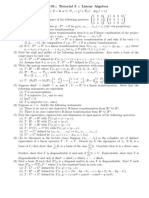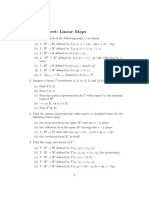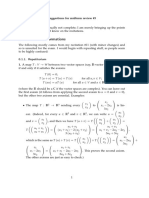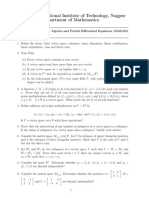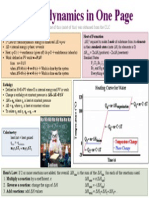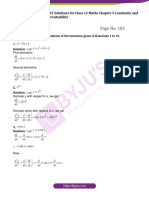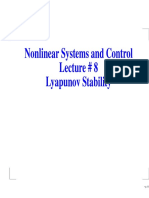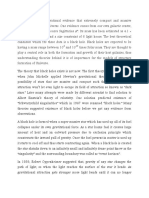Visvesvaraya National Institute of Technology, Nagpur
Department of Mathematics
Tutorial Sheet-2 Linear Algebra and Partial Differential Equations (MAL210)
1. Let F : R4 → R3 be the linear mapping defined by
F (x, y, z, t) = (x − y + z + t, x + 2z − t, x + y + 3z − 3t).
Find a basis and the dimension of: (a) the image of F , (b) the kernel of F .
2. Let G : R3 → R3 be the linear mapping defined by
G(x, y, z) = (x + 2y − z, y + z, x + y − 2z)
Find a basis and the dimension of: (a) the image of G, (b) the kernel of G.
3. Find a linear map F : R3 → R4 whose image is spanned by (1, 2, 0, −4) and (2, 0, −1, −3).
4. Let V be of finite dimension, and let F : V → W be linear transformation. show that
dimV = dim(KerF ) + dim(ImF ) = nullity(F ) + rank(F )
5. The linear map F : R2 → R2 defined by F (x, y) = (x − y, x − 2y) . Show that F is
nonsingular and find a formula for F −1 .
6. Consider linear mapping F : R3 → R2 , G : R3 → R2 , H : R3 → R2 defined by
F (x, y, z) = (x + y + z, x + y), G(x, y, z) = (2x + z, x + y), H(x, y, z) = (2y, x)
Show that F ,G, H are linearly independent.
7. Find the dimension of:
(a)Hom(R3 , R4 ), (b)Hom(R5 , R3 ), (c)Hom(P3 (t), R2 )(d)Hom(M2,3 , R4 ).
8. Suppose dim V = m and dim U = n. Show that dim[Hom(V ,U )] = mn.
9. Consider the linear operator T on R3 defined by T (x, y, z) = (2x, 4x − y, 2x + 3y − z),
(a) show that T is invertible. Find formulas for (b) T −1 (c) T 2 (d) T −2 .
10. Let F : R2 → R2 be defined by F (x, y) = (3x + 5y, 2x + 3y), and let S be the unit
circle in R2 . Find (a) the image F , (b) the preimage F −1 (S).
11. For each linear map F find a basis and the dimension of the kernel and the image of
F:
(a) F : R3 → R3 defined by F (x, y, z) = (x + 2y − 3z, 2x + 5y − 4z, x + 4y + z),
(b) F : R4 → R3 defined by F (x, y, z, t) = (x + 2y + 3z + 2t, 2x + 4y + 7z + 5t, x + 2y +
6z + 5t).
1
�12. For each linear map F find a basis and the dimension of the kernel and the image of F:
(a) F : R4 → R3 defined by F (x, y, z, t) = (x + 2y + t, 2x − y + 2z − t, x − 3y + 2z − 2t),
(b) F : R4 → R3 defined by F (x, y, z, t) = (x + 2z − t, 2x + 3y − z + t, −2x − 5z + 3t).
13. Let F : R2 → R2 be defined by F (x, y) = (2x + 3y, 4x − 5y). Find the matrix
representation [F ]s of F relative to the basis S = [u1 , u2 ] = [(1, −2), (2, −5)].
14. Let P be the change-of-basis matrix from a basis S to a basis S 0 in a vector space V .
Then, for any linear operator T on V ,
[T ]S 0 = P −1 [T ]S P
that is, if A and B are the matrix representation of T relative, respectively to S and
S 0 , then
B = P −1 AP
15. Consider the following linear operator G on R2 and basis S:
G(x, y) = (2x − 7y, 4x + 3y)andS = {u1 , u2 } = {(1, 3), (2, 5)}
(a) Find the matrix representation [G]S of G relative to S
(b) Verify [G]S [v]S = [G(v)]S for the vector v = (4, −3) in R2 .
16. For each of the following linear transformation L on R2 , find the matrix A that repre-
sents L(relative to the usual basis of R2 ):
(a) L is defined by L(1, 0) = (2, 4) and L(0, 1) = (5, 8).
(b) L is the rotation in R2 counterclockwise by 90◦ . (c) L is the reflection in R2 about
the line y = −x.
17. Let A be the matrix representation of a linear operator T . Prove that, for any polyno-
mial f (t), we have that f (A) is the matrix representation of f (T ).
18. Consider the following bases of R2 :
S = {u1 , u2 } = {(1, −2), (3, −4)}andS 0 = {v1 , v2 } = {(1, 3), (3, 8)}
(a) Find the coordinates of v = (a, b) relative to the basis S.
(b) Find the change-of-basis matrix P from S to S 0 .
(c) Find the coordinates of v = (a, b) relative to the basis S 0 .
(d) Find the change-of-basis matrix Q from S 0 back to S .
(e) Verify Q = P −1
(f) Show that, for any vector v = (a, b) in R2 , P −1 [v]S = [v]S 0 .
19. Let F : R3 → R3 be defined by F (x, y, z) = (x + 3y + z, 2x + 5y − 4z, x − 2y + 2z).
Find the matrix B that represents the linear operator F relative to the basis
S = {u1 , u2 , u3 } = {(1, 1, 0), (0, 1, 1), (1, 2, 2)}
20. Suppose B is similar to A, say B = P −1 AP . prove:
(a) B n = P −1 An P , and so B n is similar to An .
(b) f (B) = P −1 f (A)P , for any polynomial f (x), and so f (B) is similar to f (A).
(c) B is a root of polynomial g(x) if and only if A is a root of g(x).
2
�21. Let � �
2 5 −3
A=
1 −4 7
Recall that A determines a mapping F : R3 → R2 be defined by F (v) = Av, where
vectors are written as columns. Find the matrix [F] that represents the mapping relative
to the following bases of R3 and R2 :
(a) The usual bases of R3 and R2 .
(b) S = {w1 , w2 , w3 } = {(1, 1, 1), (1, 1, 0), (1, 0, 0)} and S 0 = {u1 , u2 } = {(1, 3), (2, 5)}.
22. Consider the linear transformation T on R2 defined by T (x, y) = (2x − 3y, x + 4y) and
the following bases of R2 :
E = {e1 , e2 } = {(1, 0), (0, 1)}andS = {u1 , u2 } = {(1, 3), (2, 5)}
(a) Find the matrix A representing T relative to the bases E and S.
(b) Find the matrix B representing T relative to the bases S and E.
***










